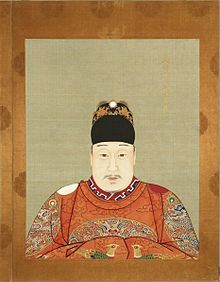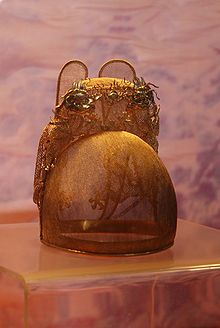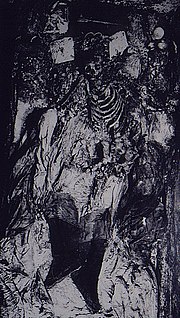Wanli Emperor
| Wanli Emperor | |||||||||||||||||
|---|---|---|---|---|---|---|---|---|---|---|---|---|---|---|---|---|---|
 | |||||||||||||||||
| 13th Emperor of the Ming dynasty | |||||||||||||||||
| Reign | 19 July 1572 – 18 August 1620 | ||||||||||||||||
| Predecessor | Longqing Emperor | ||||||||||||||||
| Successor | Taichang Emperor | ||||||||||||||||
| Regent | Gao Gong, Gao Yi (1572) Zhang Juzheng (1572–1582) | ||||||||||||||||
| Born | 4 September 1563 | ||||||||||||||||
| Died | 18 August 1620 (aged 56) | ||||||||||||||||
| Burial | |||||||||||||||||
| Spouse | Empress Xiaoduanxian Empress Xiaojing | ||||||||||||||||
| Issue | Taichang Emperor | ||||||||||||||||
| |||||||||||||||||
| House | House of Zhu | ||||||||||||||||
| Father | Longqing Emperor | ||||||||||||||||
| Mother | Empress Dowager Xiaoding | ||||||||||||||||
The Wanli Emperor (Chinese: 萬曆; pinyin: Wàn Lì; 4 September 1563 – 18 August 1620), personal name Zhu Yijun (Chinese: 朱翊鈞; pinyin: Zhū Yìjūn), was the 13th emperor of the Ming dynasty of China. "Wanli", the era name of his reign, literally means "ten thousand calendars". He was the third son of the Longqing Emperor. His reign of 48 years (1572-1620) was the longest among all the Ming dynasty emperors[2] and it witnessed the steady decline of the dynasty.
Early reign (1572–1582)
Zhu Yijun ascended the throne at the age of ten and adopted the regnal name "Wanli", thus he is historically known as the Wanli Emperor. For the first ten years of his reign, he was aided by the Senior Grand Secretary (shǒufǔ), Zhang Juzheng, who governed the country as Yijun's regent. During this period, the Wanli Emperor deeply respected Zhang as a mentor and a valued minister. Archery competitions, equestrianism and calligraphy were some of the pastimes of Wanli.[3] However, as the emperor's reign progressed, several factions within the government began to openly oppose Zhang's policies as well as to resent his powerful position in government, and tried to influence the Wanli Emperor to dismiss Zhang. By 1582, the Wanli Emperor was a young man of 19 and was tired of the strict routine of Confucian duties that Zhang still imposed on the emperor even though he was past childhood.[4] The emperor became willing to dismiss Zhang, but Zhang died in 1582 before the emperor was able to act.
During the first ten years of the Wanli era, the Ming dynasty's economy and military power prospered in a way not seen since the Yongle Emperor and the Rule of Ren and Xuan from 1402 to 1435. After Zhang's death, the Wanli Emperor felt free to act independently, and reversed many of Zhang's administrative improvements. In 1584, the Wanli Emperor issued an edict confiscating all of Zhang's personal wealth and purging his family members.
Middle reign (1582–1600)

After Zhang Juzheng's death, the Wanli Emperor decided to take complete personal control of the government. During this early part of his reign, he showed himself to be a competent and diligent emperor. Overall, the economy continued to prosper and the empire remained powerful. Unlike the last 20 years of his reign, the Wanli Emperor at this time would attend every morning meeting and discuss affairs of state.
The first 18 years of the Wanli era would be dominated by three wars that he dealt with successfully:
- Defence against the Mongols: In the northern frontier regions, a Ming general rebelled and allied with the Mongols to attack the Ming Empire. At this time, the Wanli Emperor sent Li Chengliang and his sons to handle the situation, resulting in overall success.
- Japanese invasions: Toyotomi Hideyoshi of Japan sent 200,000 soldiers in his first expedition to invade Korea. The Wanli Emperor made three strategic moves. First, he sent a 3,000-strong army to support the Koreans. Second, if Koreans entered Ming territory, he gave them sanctuary. Third, he instructed the Liaodong area to prepare for possible invasion. The first two battles fought with the Japanese were defeats since Ming troops under general Li Rusong were outnumbered and ill-prepared to fight the 200,000-strong Japanese army. The emperor then sent a bigger army of 80,000 men, with more success. This resulted in negotiations that favored the Ming. Two years later, in 1596, Japan once again invaded. However, that same year Toyotomi died and the remaining Japanese leadership lost their will to fight. Combined with the naval victories of Korean admiral Yi Sun-sin and the bogging down of Japanese forces in the Korean mainland, the demoralised Japanese army withdrew, with peace negotiations following.
- Yang Yinglong rebellion: At first, the Wanli Emperor was engaged in war with Japan and sent only 3,000 troops under the command of Yang Guozhu to fight the rebellion. However, this army was annihilated and Yang was killed. After the war with Japan ended, the Wanli Emperor turned his attention to Yang Yinglong, sending Guo Zhizhang and Li Huolong to lead the offensive. In the end, Li Huolong defeated Yang's army and brought him back to the capital.
After the last of these three wars were concluded, the Wanli Emperor withdrew from active participation in morning meetings, a practice which he continued throughout the rest of his reign.
Late reign (1600–1620)

During the later years of the Wanli Emperor's reign, he became thoroughly alienated from his imperial role and, in effect, went on strike. He refused to attend morning meetings, see his ministers or act upon memoranda. He also refused to make necessary personnel appointments, and as a result the whole top echelon of the Ming administration became understaffed. He did, however, pay close attention to the construction of his own tomb, a magnificent structure which took decades to complete.
There are several reasons why the Wanli Emperor deliberately neglected his duties as emperor. One was that he became disenchanted with the moralistic attacks and counterattacks of officials, rooted in an abstract Confucian orthodoxy.[4] A more important reason, though, was a dispute about the imperial succession. The emperor's favorite consort was Lady Zheng, and throughout the 1580s and 1590s, the emperor very much wanted to promote his son by her (Zhu Changxun) as crown prince, even though he was only the emperor's third son and not favored for the succession. Many of his powerful ministers were opposed, and this led to a clash between sovereign and ministers that lasted more than 15 years. In October 1601, the Wanli Emperor finally gave in and promoted Zhu Changluo – the future Taichang Emperor – as crown prince. Although the ministers seem to have triumphed, the Wanli Emperor adopted a policy of passive resistance, refusing to play his part in allowing the government to function adequately, leading to serious problems both within China itself and on the borders.[5]
At this time began the growth of what would become the Manchu threat. The area known as Manchuria in northeastern China was gradually conquered by the Jurchen chieftain Nurhaci. Nurhaci would go on to create the Later Jin dynasty (the precursor of the Qing dynasty), which would now become an immediate threat to the Ming dynasty. By this time, after 20 years of imperial dysfunction, the Ming army was in steep decline. While the Jurchens were fewer in number, they were fiercer and better fighters.[citation needed] For instance, in the Battle of Nun Er Chu in 1619, the Ming government sent out an army of 200,000 against the Later Jin army of 60,000, with Nurhaci controlling six banners and 45,000 troops as the central attack while Daišan and Huangtaiji each controlled 7,500 troops and one banner attacked from the sides. After five days of battle, the Ming army suffered casualties of over 100,000, with 70% of their food supply stolen.
The Oirats transmitted some garbled and incorrect descriptions of China to the Russians in 1614, the name "Taibykankan" was used to refer to the Wanli emperor by the Oirats.[6]
Palace assault
In 1615, the Ming imperial court was hit by yet another scandal. A man named Zhang Chai (張差), armed with only a wooden staff, managed to chase away the eunuchs guarding the gates and broke into Ciqing Palace (慈慶宮), then the Crown Prince's living quarters. Zhang Chai was eventually subdued and thrown into prison. Initial investigation found him to be a lunatic, but upon further investigation by a magistrate named Wang Zhicai (王之寀), Zhang Chai confessed to being party to a plot instigated by two eunuchs working under Lady Zheng. According to Zhang Chai's confession, the two had promised him rewards for assaulting the Crown Prince, thus implicating the Emperor's favorite concubine in an assassination plot. Presented with the incriminating evidence and the gravity of the accusations, the Wanli Emperor, in an attempt to spare Lady Zheng, personally presided over the case. He laid the full blame on the two implicated eunuchs who were executed along with the would-be assassin. Although the case was quickly hushed up, it did not quash public discussion and eventually became known as the "Case of the Palace Assault" (梃擊案), one of three notorious 'mysteries' of the late Ming dynasty.
Family
Consorts

- Empress Xiaoduanxian (1564–1620), had no sons. She gave birth to the first of the emperor's ten daughters, Princess Rongchang (1582-1642).
- Lady Wang, later Imperial Noble Consort Wensu, later Empress Dowager Xiaojing (1565–1612), mother of Zhu Changluo (the Taichang Emperor). Initially she was a maid of the Empress Dowager who caught the eye of the Wanli Emperor, Later, however, the emperor only favoured Lady Zheng, and all but ignored Xiaojing. Because of this, Zhu Changluo was not created crown prince until 1601. Her grandson, the Tianqi Emperor, promoted her to Empress Dowager, and she was exhumed from an Imperial Concubine's tomb and re-buried in the Wanli Emperor's tomb. The Wanli Emperor therefore was the only Ming emperor buried with two wives.
Concubines
- Lady Zheng (c. 1567–1630). She was the Wanli Emperor's favourite concubine and gave birth to the emperor's third and fourth sons - Zhu Changxun (1586-1641) and Zhu Changzhi (1587-1588). The Wanli Emperor was unable to promote Lady Zheng to Empress during his reign as well declare Zhu Changxun, his son by her, as crown prince due to the opposition of his ministers. The emperor eventually promoted Lady Zheng to Empress on his deathbed in 1620. However, this order was never carried out. In 1644, since the Hongguang Emperor, the first ruler of the Southern Ming dynasty, was a grandson of Lady Zheng, the lady was finally promoted as Empress by the Southern Ming government, 14 years after her death.
- Lady Li (d. 1597), honoured as Imperial Noble Consort Gongshun.
- Lady Liu (1557–1642), honoured as Consort Xuanyizhao.
- Lady Xu (d. 1602), honoured as Consort Zhuangjingde.
- Lady Chang (1568–1594), honoured as Consort Wenjingshun.
- Lady Li (d. 1623), honoured as Consort Qinghuishun.
- Lady Wei, honoured as Consort Xian.
- Lady Zhou, honoured as Consort Duan.
- Lady Yang, honoured as Consort Yi.
- Lady Wang (d. 1589), honoured as Consort Xi.
- Lady Wang (d. 1591), honoured as Consort Duanjingrong.
- Lady Li, honoured as Imperial Concubine Rong.
- Lady Li (1567–1628), honoured as Imperial Concubine De.
- Lady Geng (1568–1589), honoured as Imperial Concubine Wei.
- Lady Liang (1562–1643), honoured as Imperial Concubine He.
- Lady Shao, honoured as Imperial Concubine Jing.
- Lady Zhang, honoured as Imperial Concubine Shun.
- Lady Wei, honoured as Imperial Concubine Shen.
Sons
The Wanli Emperor fathered eight male children. The eldest became the Taichang Emperor, and another three died at a very young age. Others were executed during the early years of the Qing dynasty.
- Zhu Changluo (1582-1620), the Taichang Emperor, son of Empress Dowager Xiaojing.
- Zhu Changxu (1584-1585), son of Consort Wenjingshun.
- Zhu Changxun (1586-1641), son of Lady Zheng.
- Zhu Changzhi (1587-1588), son of Lady Zheng. His premature death made the Wanli Emperor grief-stricken.
- Zhu Changhao (1590-1644), son of Consort Duan. Executed in 1644.
- Zhu Changrun (1594-1647), son of Imperial Noble Consort Gongshun. Executed in 1647.
- Zhu Changying (1597-1645), son of Imperial Noble Consort Gongshun. Father of the Yongli Emperor.
- Zhu Changpu (1604-1606), son of Consort Qinghuishun.
Daughters
The Wanli Emperor fathered ten daughters, but only the first two survived childhood.
- Princess Rongchang (1582-1647), daughter of the Empress. Married Yang Chunyuan.
- Princess Shouning (1584-1643), daughter of Lady Zheng. Married Ran Xing (committed suicide 1644).
- Zhu Xuangui (1584-1585), daughter of Lady Wang.
- Zhu Xuanshu (1584-1590), daughter of Lady Zheng.
- Zhu Xuanxianju (1584-1585), daughter of Imperial Concubine De.
- Zhu Xuanyao (1588-1589), daughter of Lady Zheng.
- Zhu Yunmeng (1584-1587), daughter of Lady Wang.
- Zhu Xuanji (d. 1593), daughter of Imperial Concubine De.
- Zhu Xuandeng (1598-1599), daughter of Imperial Concubine De.
- Zhu Xuanmei (1605-1606), daughter of Consort Qinghuishun.
Legacy and death

Many scholars of Chinese history believe that the Wanli Emperor's reign was a significant factor contributing to the decline of the Ming dynasty. He refused to play the emperor's role in government, and delegated many responsibilities to eunuchs, who made up their own faction. The official administration was so dissatisfied that a group of scholars and political activists loyal to the thoughts of Zhu Xi and against those of Wang Yangming created the Donglin Movement, a political group who believed in upright morals and tried to influence the government according to strict Neo-Confucian principles.
His reign also experienced heavy fiscal and military pressures, especially since during the final years of the Wanli era, when the Manchus began to conduct raids on the northern border of the Ming Empire. Their depredations ultimately led to the fall of the Ming dynasty in 1644. It has been said that the fall of the Ming dynasty was not a result of the Chongzhen Emperor's rule but instead due to the Wanli Emperor's gross neglect of his duties as Emperor.
The Wanli Emperor died in 1620 and was buried in the Dingling Mausoleum among the Ming tombs on the outskirts of Beijing. His tomb is one of the biggest in the vicinity and one of only two that are open to the public. The tomb was excavated in 1956, and remains the only imperial tomb that had been excavated since the founding of the People's Republic of China in 1949. In 1969, during the Cultural Revolution, Red Guards stormed the Dingling Mausoleum, and dragged the remains of the Wanli Emperor and his two empresses to the front of the tomb, where they were posthumously "denounced" and burned after photographs were taken of their skulls. Thousands of other artifacts were also destroyed.[8]
In 1997, China's Ministry of Public Security published a book on the history of drug abuse. It stated that the Wanli Emperor's remains had been examined in 1958 and found to contain morphine residues at levels which indicate that he had been a heavy and habitual user of opium.[9] According to Dikötter's Narcotic Culture: A History of Drugs in China, Madak was introduced in China by Dutch traders between 1624 and 1660.[10] Before that, Chinese only used opium in medicinal purposes, so therefore the Wanli Emperor could not have been addicted in smoking opium.[11]
The Wanli Emperor's contribution to the defense of the Joseon dynasty in Korea against the Japanese invasion has endeared him to Koreans over the centuries. In the late 1990s, Koreans still paid respect to the Wanli Emperor.
In many ways, he was similar to other Chinese emperors who were initially successful but later deteriorated, contributing to their dynasty's eventual overthrow, such as the Emperors Gaozong and Xuanzong of the Tang dynasty, and the Qianlong Emperor of the Qing dynasty.
Notes
- ^ Following the death of the emperor, the Wanli era was normally due to end on 21 January 1621. However, the Wanli Emperor's successor, the Taichang Emperor, died within a month, before 22 January 1621, which should have been the start of the Taichang era. The Tianqi Emperor, who succeeded the Taichang Emperor, decided that the Wanli era would be considered as having ended on the last day of the seventh month (equivalent to 27 August 1620), to enable the Taichang era to be applied retrospectively for the remaining five months in that year (see the Taichang Emperor article).
- ^ a b Frederick W. Mote (2003). Imperial China 900-1800. Harvard University Press. pp. 727–. ISBN 978-0-674-01212-7.
- ^ Frederick W. Mote; Denis Twitchett (26 February 1988). The Cambridge History of China: Volume 7, The Ming Dynasty, 1368-1644. Cambridge University Press. pp. 514–. ISBN 978-0-521-24332-2.
- ^ a b Huang, Ray(1981) 1587, a Year of No Significance: The Ming Dynasty in Decline. New Haven: Yale University Press. ISBN 0-300-02518-1
- ^ Goodrich, Carrington L.; Fang, Chaoying, eds. (1976). Dictionary of Ming Biography. New York: Columbia University Press. ISBN 0-231-03801-1.
{{cite book}}: Unknown parameter|lastauthoramp=ignored (|name-list-style=suggested) (help) - ^ Peter C Perdue (30 June 2009). China Marches West: The Qing Conquest of Central Eurasia. Harvard University Press. pp. 100–. ISBN 978-0-674-04202-5.
- ^ "China's reluctant Emperor", The New York Times, Sheila Melvin, Sept. 7, 2011.
- ^ "China's reluctant Emperor", The New York Times, Sheila Melvin, Sept. 7, 2011.
- ^ Zheng Yangwen (2005). The Social Life of Opium in China. Cambridge: Cambridge University Press. pp. 18–19. ISBN 0-521-84608-0.
- ^ Frank Dikötter; Lars Peter Laamann; Zhou Xun (2004). Narcotic Culture: A History of Drugs in China. Chicago: University of Chicago Press, C. Hurst & Co. Publishers. p. 32. ISBN 1-85065-725-4.
- ^ Frank Dikötter; Lars Peter Laamann; Zhou Xun (2004). Narcotic Culture: A History of Drugs in China. Chicago: University of Chicago Press, C. Hurst & Co. Publishers. pp. 24–31. ISBN 1-85065-725-4.
References
Huang Ray, 1587, a Year of No Significance: The Ming Dynasty in Decline. New Haven: Yale University Press, 1981. ISBN 0300-025181
Huiping Pang, "The Confiscating Henchmen: The Masquerade of Ming Embroidered-Uniform Guard Liu Shouyou (ca. 1540-1604)," Ming Studies 72 (2015): 24-45. ISSN 0147-037X
